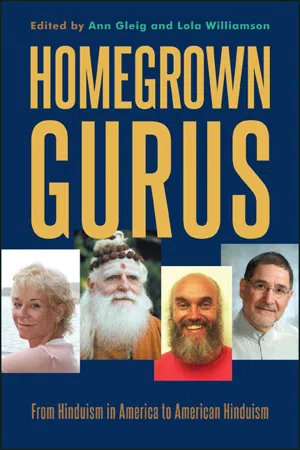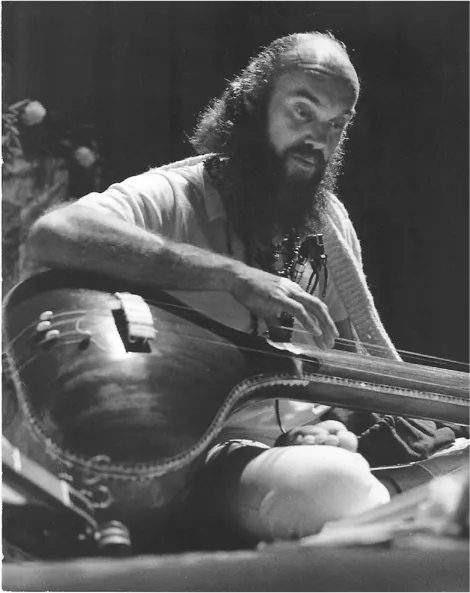![]()
1
Ram Dass
The Vicissitudes of Devotion and Ferocity of Grace
F. X. Charet
The following focuses on one example of the influence of contemporary Indian gurus in the West by exploring the personal backgrounds and contexts of American-born Ram Dass and his Indian guru Neem Karoli Baba, as well as the transformation of ideas, beliefs, and practices that have occurred in the process of this particular transmission of Hinduism to America.1 Ram Dass has been instrumental in bringing Indian spirituality and practices to America in what could be termed the second great awakening of Eastern spirituality in the 1960s and 1970s, the first being initiated by the presence of Vivekananda and others at the 1893 World Parliament of Religions in Chicago. The story of how Dr. Richard Alpert became Ram Dass, one of the foundational figures of the so-called New Age and a popular spokesperson for a range of Indian-inspired beliefs and practices, is a fascinating and largely unexamined one.2 It also provides an example of how ideas and beliefs can be intimately connected with an individual’s personal history and psychology and illustrates the considerable change that ideas undergo as they are transplanted from one cultural context into another.3
This chapter examines the encounter between Neem Karoli Baba and Ram Dass, the background out of which this encounter arose, and the results it had on the loosely knit satsang (spiritual community) of Western devotees and fellow travelers. The chapter demonstrates how the bhakti (devotional) Hinduism that Neem Karoli Baba practiced, advocated, and embodied, with its sources in the emerging Hanuman tradition in India, its mix of sectarian Vaishnava and Shaiva belief, practice, and iconography, has considerably morphed and transformed under Ram Dass’s tutelage as it found its way into the West. The satsang under Ram Dass’s direction, following the publication of Be Here Now (1971), produced its foundational literature in the subsequent gospel text, Miracle of Love: Stories about Neem Karoli Baba (1979), while also establishing several organizations and programs such as the Hanuman and Seva foundations and the prison and hospice projects.
This first generation, still in existence and clearly influential, is now beginning to give way to a subsequent generation whose ties to its putative leader and inspiration, Neem Karoli Baba, are largely created through media, including a number of publications, stories, films, and photographs.4 The new generation is also, in part, anchored in the one full-fledged center in the West, the Neem Karoli Baba Ashram in Taos, New Mexico.5 This, in turn, is supported by the distant living presence of Neem Karoli’s much-beloved successor and keeper of his memory, the aged Siddhi Ma of Kainchi Ashram, Uttarakhand, where the first generation of the Western satsang encountered Neem Karoli Baba. This chapter’s main focus, though, will be on the journey of Richard Alpert—from his early experiments with psychoactives and his troubling sexuality, to his encounter with the living spirituality of contemporary Hinduism, to the unmaking of his potential status as guru and the making of his identity as Ram Dass, the devotee and, finally, the remaking of him into an American guru.
Figure 1.1. Ram Dass playing the tamboura (Photo courtesy of Love Serve Remember Foundation)
Richard Alpert: Sex, Drugs, and Spirituality
Ram Dass has briefly sketched his own background and what led him to his fateful encounter with Neem Karoli Baba in Be Here Now and repeated it numerous times in his many presentations. In these accounts he offers little detail about his early life, but does say he was inordinately attached to his mother, somewhat removed from his distant and successful father, and stemmed from an affluent New England “Jewish anxiety-ridden high-achieving tradition.”6 His undergraduate and graduate schooling at Tufts and Wesleyan was conventional and his athletic and academic accomplishments were undistinguished. Nevertheless, following his doctoral studies at Stanford, more due to his skills as a lecturer and connections than research and scholarship, his rise in the world of academic psychology was swift and successful. He served in various roles at Stanford and finally at Harvard, where he secured a position that would lead to tenure. Outwardly, he was in an enviable position and a paragon of success. Inwardly, he was neurotic, sexually troubled, and deeply unhappy.7
The early 1960s witnessed the beginning of experimentation with various substances, from street-available marijuana and psilocybin to laboratory produced LSD. This countercultural phenomenon attracted the attention of several professionals in psychiatry and psychology, including Ram Dass, then Dr. Richard Alpert, who was later joined at Harvard by another psychologist, Timothy Leary, who eventually achieved considerable notoriety. The common version of what happened is that Leary and Alpert became heavily involved in experimenting with these substances, especially the psychedelics, and encouraged their students and others to do likewise. They saw themselves as pioneers in the mapping of the mind and in exploring the further reaches of consciousness, but they encountered opposition from conservative forces at Harvard and elsewhere. This inevitably led to their 1963 dismissal from their positions at Harvard. The media portrayed them as radical promoters of dangerous mind-altering substances. The reality is that this picture, oft repeated and largely mirrored in the media, is only partially true. The full truth is more complex and hides dark forces in Alpert’s life.
In fact, as a teenager Alpert had ongoing difficulties in school and not only felt oppressed by his successful lawyer father’s ambitions for him, but also experienced a deep sense of inadequacy intellectually, emotionally, and sexually. He had unsuccessfully tried to enter Harvard and resisted his father’s influence that would have allowed him to be admitted to medical school at Tufts, the other profession to which a young Jew of his background should aspire. Instead, he headed for Stanford to study psychology and succeeded in obtaining his doctorate with a dissertation that focused on academic anxiety. Between the more liberal atmosphere of San Francisco and staid Boston, he lived something of a double life, a subject that has not surfaced in his accounts of these years until more recent times. While on occasion he admitted in passing his bisexuality, he did not disclose his early teenage struggles with his emerging homosexuality, as well as how sexually active he was when at Stanford and later at Harvard, until he gave numerous interviews for gay publications in the 1990s. As he confessed, “I’m sure I’ve had thousands of sexual encounters. It was often two a night.”8 In fact, this behavior figured prominently in the circumstances surrounding his dismissal from Harvard.
Just before the Harvard debacle, Alpert, Leary, and several of their followers moved into a residence Alpert purchased in Newton, a town outside Boston. The house in Newton was renovated to accommodate Leary’s eccentric ideas on maintaining a self-contained, closed space to enhance the many psychedelic sessions they were conducting. Neighbors were so displeased by the comings and goings, loud music, and behavior that they tried to have the many occupants evicted. Alpert’s father appeared before the board of zoning appeals and successfully argued for the rights of the occupants to be considered “a family,” thereby staving off eviction. Various members of “the family” shared tasks, and gender differences and traditional roles became blurred, as did boundaries of sexual intimacy.9 In addition to experimenting with mind-altering substances, Alpert wanted to “turn on” the many young men with whom he was having relations. Medical student Andrew Weil influenced an editor of The Crimson, the Harvard school newspaper, to print an exposé of the dubious scientific value of the experimenting that was occurring and that eventually resulted in Alpert’s termination.10 As Alpert stated more candidly than ever before in an interview with Mark Thompson published in 1994:
Tim Leary and I and a lot of friends had one of these big community houses. We got into a situation where Harvard started to get so freaked about the drugs we were using that they asked us to stop doing our research using any undergraduates. We could use graduate students, or outside populace, but we couldn’t use undergraduates because it was too risky. But I had all these relationships with young men whom I really wanted to turn on with. And it had nothing to do with our research; it was my personal life, so I went ahead. It turned out there was another student who was very jealous of this, an editor of the campus newspaper, and he created a huge exposé.
[Thompson:] So it was gay eros and not LSD that got you thrown out of Harvard?
[Alpert:] It was a combination of all those things. In a way, LSD had given me the license to be what I am. It looked at me inside and out and said what you are is okay. And that gave me a license to start to say I didn’t want to hide anymore.11
But much as drug-induced states may have enhanced Alpert’s sexual proclivities, they also deeply divided him. For a time he even entertained the possibility of ridding himself of his homosexuality with the aid of psychedelics by going deep enough to uncover its roots and alter his sexual orientation.12 Moreover, in the depths of his mind-altering experiences, a transpersonal and spiritual dimension surfaced that had a significant impact on him. In the summer of 1961, at the Fourteenth International Congress for Applied Psychology held in Copenhagen, Alpert surprised everyone, including Leary, by announcing from the podium during Leary’s presentation that drug-induced altered states had religious implications and led to a mystical end that resulted in love and peace.13 The famous “Good Friday Experiment” undertaken in Marsh Chapel at Boston University the following year further enhanced this view when several theological students were administered psilocybin, the majority of whom reported extraordinary experiences of being in the presence of the divine.14
Added to this were the extensive associations Alpert and Leary made openly with various spiritual practices and experiences. In particular, Eastern religions, rituals, and practices, along with available textual sources became of considerable interest. They eventually wrote a book, The Psychedelic Experience: A Manual Based on the Tibetan Book of the Dead (1964), coauthored with Ralph Metzner. Parallels and connections were made between the altered states induced by the ingestion of psychedelics and bardo states reported in The Tibetan Book of the Dea...

